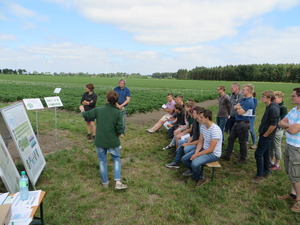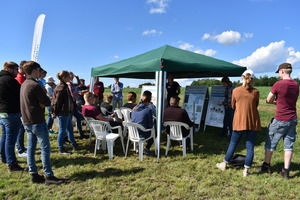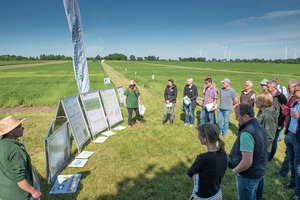Long-term ground water protection field trials to test adapted crop rotation and nitrogen-fertilization
Field experiment 2, Germany



Trial location and duration
Germany, Hamerstorf (52°55′ 0.33″N, 10° 27′ 32″E) and Thülsfelde (52°56′ 13″N, 7° 55′ 53″E)
Duration:
Hamerstorf: 2014-present / Thülsfelde: 2009-present
Objectives and research question
The goals set by the EU-water framework directive put many conventional arable cropping systems under pressure. A lack of soil cover for longer periods and poorly adapted fertilization strategies led to increasing nitrate-concentrations in water bodies. This occurs especially on sandy soils which have a lower nutrient-storage capacity, resulting not only in a higher nitrogen leachate but also in lower yield potentials.
The focus of the water protection field trials is to decrease nitrate leaching in groundwater. For this purpose, leachate water tests are carried out at five sites in Thülsfelde, Wehnen, Hamerstorf and Schickelsheim by the State Office for Mining, Energy and Geology (LBEG) of Lower Saxony. The sites at Thülsfelde and Hamerstorf are included in the DiverIMPACTS field experiment. By using fixed N-fertilization stages, the examined parameters such as soil mineral nitrogen-values or yield can be interpolated for a defined N-fertilization and compared for year-specific soil and weather conditions. To be able to perform these calculations correctly, trials with different (low to excessive) N-fertilization are also included.
The water protection field trials in Thülsfelde und Hamerstorf are focused on the impacts of different crop rotations. The main underlying questions on these sites are:
- What effect does N-fertilization and crop rotation have on the nitrate-concentration in water?
- How do the levels of N-fertilization and crop rotation affect N-dynamics in the soil, yield and other quality-parameters?
- How can the water quality be increased by a water protecting crop rotation and an adjustment of N-fertilization?
The experiments are part of a field experiment-system led by the Chamber of agriculture Lower Saxony and are financed by the Lower Saxony water-treatment charge. The data obtained from them is used in the DiverIMPACTS project.
Experimental design
Both sites have three spatial replications of each system, and no temporal replication. There are two tested systems:
- Site in Hamerstorf: one reference and one diversified rotation are tested
- Site in Thülsfelde: one reference and two diversified rotations are tested.
1. Hamerstorf:
- Reference rotation: Potato – winter rye – silage maize – brewing barley
- Diversified rotation: Potato – cover crop – winter rye (silage) with undersown grasses – silage maize with undersown grasses – brewing barley with undersown grasses
- The diversified system is designed with the focus on water protection purposes.
2. Thülsfelde:
- Reference: Silage maize – silage maize – winter rye
- Diversified rotation 1: Silage maize – winter rye – winter barley – cover crop
- Diversified rotation 2: Silage maize – winter rye – cover crop – spring barley – cover crop
- The diversified systems are designed with the focus on water protection purposes. The experiment originally started 1996 and the current rotations were set up 2009.
Main findings and Highlights
Actual results of these sites and other experiments can be found on the website of the Chamber of Agriculture (see link below in German). Main findings and challenges will be made available here as soon as possible.
Further information
- duengebehoerde-niedersachsen.de: Water protection trial results (Wasserschutzversuche)
- zenodo.org: Mit diversen Fruchtfolgen den Wasserschutz stärken – LWK & DiverIMPACTS
 tap and then scroll down to the Add to Home Screen command.
tap and then scroll down to the Add to Home Screen command.